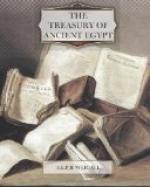The fact that the body in the new tomb was that of Akhnaton, and not of Queen Tiy, gives a new reading to the history of the burial. When Tutankhamon returned to Thebes, Akhnaton’s memory was still, it appears, regarded with reverence, and it seems that there was no question of leaving his body in the neighbourhood of his deserted palace, where, until the discovery of this tomb, Egyptologists had expected to find it. It was carried to Thebes, together with some of the funeral furniture, and was placed in the tomb of Queen Tiy, which had been reopened for the purpose. But after some years had passed and the priesthood of Amon-Ra had again asserted itself, Akhnaton began to be regarded as a heretic and as the cause of the loss of Egypt’s Asiatic dominions. These sentiments were vigorously encouraged by the priesthood, and soon Akhnaton came to be spoken of as “that criminal,” and his name was obliterated from his monuments. It was now felt that his body could no longer lie in state together with that of Queen Tiy in the Valley of the Tombs of the Kings. The sepulchre was therefore opened once more, and the name Akhnaton was everywhere erased from the inscriptions. The tomb, polluted by the presence of the heretic, was no longer fit for Tiy, and the body of the Queen was therefore carried elsewhere, perhaps to the tomb of her husband Amenhotep III. The shrine in which her mummy had lain was pulled to pieces and an attempt was made to carry it out of the tomb; but this arduous task was presently abandoned, and one portion of the shrine was left in the passage, where we found it. The body of Akhnaton, his name erased, was now the sole occupant of the tomb. The entrance was blocked with stones, and sealed with the seal of Tutankhamon, a fragment of which was found; and it was in this condition that it was discovered in 1907.
The bones of this extraordinary Pharaoh are in the Cairo Museum; but, in deference to the sentiments of many worthy persons, they are not exhibited. The visitor to that museum, however, may now see the “canopic” jars, the alabaster vases, the gold vulture, the gold necklace, the sheets of gold in which the body was wrapped, the toilet utensils, and parts of the shrine, all of which we found in the burial-chamber.
CHAPTER IX.
THE TOMB OF HOREMHEB.
In the last chapter a discovery was recorded which, as experience has shown, is of considerable interest to the general reader. The romance and the tragedy of the life of Akhnaton form a really valuable addition to the store of good things which is our possession, and which the archaeologist so diligently labours to increase. Curiously enough, another discovery, that of the tomb of Horemheb, was made by the same explorer (Mr Davis) in 1908; and as it forms the natural sequel to the previous chapter, I may be permitted to record it here.




